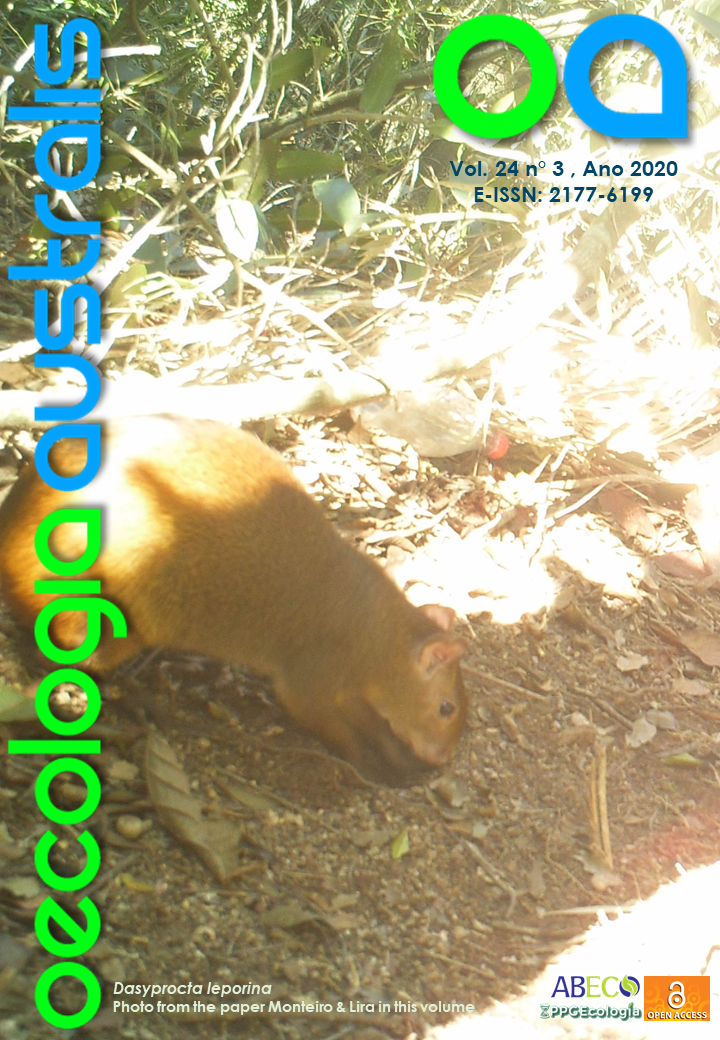EMERGENCE TRAP FOR THE COLLECTION OF EXUVIAE AND ADULT OF ODONATAs
DOI:
https://doi.org/10.4257/oeco.2020.2403.18Keywords:
cerrado, damselflies, dragonflies, larvae, streamAbstract
Odonates have aquatic larval stages and terrestrial adults. The extreme change in habitat occupation during their life cycle means that combined collection methods, capable of providing data for both larvae and adults, are scarce and are often inefficient. Given this, we applied a method for the collection of specimens of both life phases using emergence traps. During fieldwork, 78 emergence events were recorded for 15 species. We also briefly discuss the emergence pattern of the recorded species. We believe the information obtained here provide an important contribution to the understanding of the ecology and basic biology of Neotropical odonate species, as well as helping to solve the taxonomic problems associated with the identification of larvae.
References
Bispo, P. C., Oliveira, L. G., Bini, L. M., & Sousa, K. G. 2006. Ephemeroptera, Plecoptera and Trichoptera assemblages from riffles in mountain streams of Central Brazil: environmental factors influencing the distribuition and abundance of immatures. Brazilian Journal of Biology, 66(2), 611–622. DOI: 10.1590/S1519-69842006000400005
Calvão, L. B., De marco, P., Batista, J. D. 2014. Odonata (Insecta) from Nova Xavantina, Mato Grosso, Central Brazil: information on species distribution and new records. Check List, 10(2), 299–307.
Carvalho, A. L., & Nessimian, J. L. 1998. Odonata do estado do Rio de Janeiro, Brasil: habitats e hábitos das larvas. Oecologia Brasiliensis, 5, 3–28
Corbet, P.S. 1999. Dragonflies: Behavior and ecology of Odonata. Colchester: Harley Books: p. 889.
David, I. J. 1984. Sampling aquatic insect emergence. In: J. A. Downing, & F. H. Rigler (Eds.), A manual on the methods for assessment of secondary productivity in freshwaters. pp. 161–227. Oxford: Blackwell Scientific Publications.
Giehl, N. F. S., Fonseca, P. V. B., Dias-silva, K., Brasil, L. S., Cabette, H. S. R. 2015. Efeito de fatores abióticos sobre Brachymetra albinervis albinervis (Heteroptera: Gerridae). Iheringia Série Zoologia, 105(4), 411–415.
Gibbs, K. E., Mingo, T. M. 1986. The life history, nymphal growth rates, and feeding habits of Siphlonisca aerodroma Needham (Ephemeroptera: Siphlonuridae) in Maine. Canada Journal Zoology, 64(2), 427–430. DOI: 10.1139/z86-066
Gonçalves, F. B., & Aranha, J. M. R. 2004. Ocupação espaço-temporal pelos macroinvertebrados bentônicos na bacia do rio Ribeirão Paranaguá, PR (Brasil). Acta Biológica Paranaense, 33(1,2,3,4), 181–747.
Hayden, W., & Clifford, H. F. 1974. Seasonal movements of the mayfly Leptophlebia cupida (Say) in a brown-water stream of Alberta, Canada. American Midland Naturalist, 91(1), 90–102. DOI: 10.2307/2424513
Miguel, T. B., Calvão, L. B., Vital, M. V. C., & Juen, L. 2017. A scientometric study of the order Odonata with special attention to Brazil. International Journal Odonatology, 20(1), 1–16. DOI: 10.1080/13887890.2017.1286267
Moore, M. P., Lis, C., & Martin, R. A. 2018. Larval body condition regulates predator-induced life-history variation in a dragonfly. Ecology, 99(1), 224–230. DOI: 10.1002/ecy.2056
Needham, J. G. 1908. Report of the entomological field station conducted at Old Forge, N.Y. in the summer of 1905. Bull NewYork, 124 (3),167–172.
Neiss, U. G., & Hamada, N. 2014. Ordem Odonata. In: N. Hamada, J. G. Nessimian, & R. B. Querino (Eds.), Insetos aquáticos na Amazônia brasileira: taxonomia, biologia e ecologia. pp. 217–284. Manaus: Instituto de Pesquisa da Amazônia - INPA.
Salvarina, I., Gravier, D., & Rothhaupt, K.O. 2017. Seasonal insect emergence from three different temperate lakes. Limnologica, 62(1), 47–56.
Suhaila, A. H., Che Salmah, M. R., & Nurul, H. A. 2016. Composition and distribution of Odonata larvae and its relationship with physicochemical water quality in Northern Peninsular Malaysia. Malaysia Journal Science, 35(1), 213–225.
Tavares, R. I. S., Mandelli, A. M., Mazao, G. R., & Guillermo-Ferreira, R. 2017. The relationship between habitat complexity and emergence time in damselflies. Limnologica, 65(2): 1–3.
Trapero-Quintana, A., & Reyes-Tur, B. 2011. Patrones de emergencia de odonata en Las Cuabas, Santiago De Cuba. La Sea, 46(1), 273–280.
Trapero-Quintana, A., & Reyes-Tur, B. 2017. Patrones de emergencia de Odonata (Insecta) en un hábitat lótico de Cuba oriental. Revista de Biología Tropical, 65(2), 807–818. DOI: 10.15517/rbt.v65i2.25532
Verheyen, J., Temmerman, K., De Block, M., & Stoks, R. 2018. Voltinism associated differences in winter survival across latitudes: integrating growth, physiology, and food intake. Oecologia, 186(4): 919–929.


